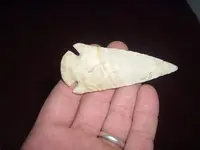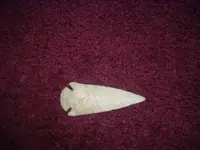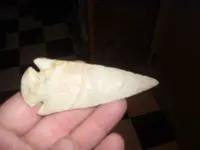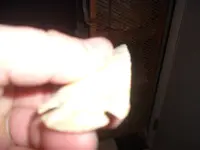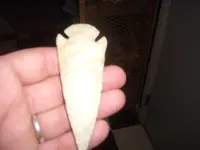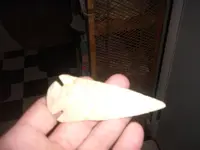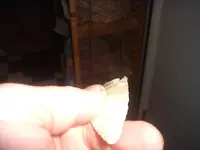You are using an out of date browser. It may not display this or other websites correctly.
You should upgrade or use an alternative browser.
You should upgrade or use an alternative browser.
FLEA Market FIND.
- Thread starter choo
- Start date
What does the other side look like?
creek astronaut
Bronze Member
thats one heck of a flea market find.you did get your moneys worth,that would fetch ALOT more than a 100 dollars.i dont want to be raining on your parade but when a piece like that is getting sold for a hundred bucks i get a little skeptical,i hope it is as authentic as it is nice to look at. 

Smurufett
Full Member
- Joined
- Sep 8, 2009
- Messages
- 113
- Reaction score
- 42
- Golden Thread
- 0
- Location
- East Texas
- Detector(s) used
- My hands and bare feet!
It is real nice . It looks like it is ding up pretty good on the edges, making it worth not as much . I would be careful at the flea markets . True you can get good deals if they find it theirself's and are not familiar with the trade market. Did he give you the county were the point was found? Did he find it himself? If he is a collector, he more than likely selling stuff he does not want to keep for his collection. Just some things I think about when I am purchasing points. Oh and being "papered" in my opinion does not make an artifact more valuable to me. It is just someone else's opinion on paper. Could we some some better pics by chance? You could try looking at it through a maginfying glass to get a better look at it.
creek astronaut
Bronze Member
those dings are very minor and are probably ancient if the piece is ancient,that piece would grade a g-9 without a doubt.a g-9 dove made of killer material like that one and im guessing around 4 inches long would easily go for a grand or more not a hundred dollars.i agree with you that it may have been sold by someone unfamiliar with its value.and when it comes to papered points,well those get faked too.Smurufett said:It is real nice . It looks like it is ding up pretty good on the edges, making it worth not as much . I would be careful at the flea markets . True you can get good deals if they find it theirself's and are not familiar with the trade market. Did he give you the county were the point was found? Did he find it himself? If he is a collector, he more than likely selling stuff he does not want to keep for his collection. Just some things I think about when I am purchasing points. Oh and being "papered" in my opinion does not make an artifact more valuable to me. It is just someone else's opinion on paper. Could we some some better pics by chance? You could try looking at it through a maginfying glass to get a better look at it.
Th3rty7
Silver Member
The only thing that bothers me about the piece is the pristine condition and perfect notches, they look too good to be true. I could be totally wrong and would have to examine it in hand to give an honest opinion. If authentic with no modern retouch you did well, doves of that size, material and quality go for several times more than what you have in it.
creek astronaut
Bronze Member
looks pretty good to me too,i didnt notice any dings until smurufett said something and then i had to look real hard to see any, maybe what you may call the slightest of dings on the upper part of the blade but that is splittin hairs.looks like a freakn perfect piece to me.nothing stuck out to me about the piece other than how much was paid for it.its like someone sellin a brand new 50,000 sportscar for 10,000.just made me somewhat skeptical.maybe the seller didnt know its true value??SoIll said:Looks pretty good to me. btw: what dings?
*Molly*
Silver Member
Nice point. I would still have it authenticated.
Flea markets in NC are full of arrows but, not one authentic. They look good but, one can tell..
Molly.
Flea markets in NC are full of arrows but, not one authentic. They look good but, one can tell..
Molly.
Would still like to see the other side, I see very little if any patina on this side, but that doesn't always mean a lot till it is looked at under a microsope, they can fake patina with acid.
Just a word of caution, be very careful buying from flea markets unless you know the seller or he will give you a guarantee that if it fails authentication you get your money back, if he want I would stear clear, there are thousands of recently knapped points out there being sold as real artifacts. I have seen a lot of fakes at flea markets.....
Just a word of caution, be very careful buying from flea markets unless you know the seller or he will give you a guarantee that if it fails authentication you get your money back, if he want I would stear clear, there are thousands of recently knapped points out there being sold as real artifacts. I have seen a lot of fakes at flea markets.....
Sorry choo, they are too out of focus to see anything, one just like first picture you originally posted only the opposite side would be nice enough.
joshuaream
Silver Member
- Joined
- Jun 25, 2009
- Messages
- 3,170
- Reaction score
- 4,512
- Golden Thread
- 0
- Location
- Florida & Hong Kong
I've been wrong many times before, but if I had a chance to get my money back I would... Aside from the tail, Ohio/Indiana/Northern Kentucky Dovetails have some unique design charateristics that set them apart as their own cluster, and that piece just looks like it's missing those traits.
To be a bit more specific, I don't like the notches and the way it was resharpened, but the flaking is the big red flag for me. Look at some of the recent posts about dovetails here, specifically the doves pictured in the Flint Ridge Blades post and another post from last month called Awesome Dovertail, and you'll see really good pictures of classic eastern big Dovetail flaking. The ancient knappers took heavier flakes that are usually wider and deeper than the flaking on later points, and fakes often have shallow more random flaking that ends up looking like a snyder point with a dovetail base.
Doves from Illinois/Missouri often have that heavy flaking, but not always. That said, their resharpening method results in a different blade shape than that guy...
To be a bit more specific, I don't like the notches and the way it was resharpened, but the flaking is the big red flag for me. Look at some of the recent posts about dovetails here, specifically the doves pictured in the Flint Ridge Blades post and another post from last month called Awesome Dovertail, and you'll see really good pictures of classic eastern big Dovetail flaking. The ancient knappers took heavier flakes that are usually wider and deeper than the flaking on later points, and fakes often have shallow more random flaking that ends up looking like a snyder point with a dovetail base.
Doves from Illinois/Missouri often have that heavy flaking, but not always. That said, their resharpening method results in a different blade shape than that guy...
artorius
Sr. Member
I would have the point authenticated. It is very difficult to authenticate many points from a photo, and this is such an occasion.
I am not seeing in the photos any iron stains or deposits. While not all genuine artifacts have them, localized iron strains and deposits are reassuring (albeit not absolutely conclusive).
artorius
I am not seeing in the photos any iron stains or deposits. While not all genuine artifacts have them, localized iron strains and deposits are reassuring (albeit not absolutely conclusive).
artorius
creek astronaut
Bronze Member
first, due to the pic and color of the material you really cant see the flaking or resharpening on this piece atleast not on my screen,and just because it wasnt resharpened doesnt mean it isnt authentic.as far as the notches go, yea sure they are very pristine,but there is no way you can tell if they are fake unless you have a microscope and can really see if the hinge fractures are ancient.and i didnt really want to go here but i will.the awesome dovetail post,well to be quite frank i question the featured piece in that post more than i do the dove in this one.there is absolutely nothing about that dove that looks like a dove other than the shape of the base.the flaking is NOT a typical dove flaking and the fine edge work that is typical for a classic eastern dove is not present and i have picked up more ancient ridge than most and i know ridge patina when i see it,and well there isnt any on it..and i do respectfully disagree with you on the flaking style of doves.they are not deep heavy flakes,but much more precise parrallell flaking and fine edge work.the flaking on the dove in the awesome dovetail post resembles more of what you would find on a snyders than a dove.figure that out??and since we are talking doves, you did mention blade shape, a common trait in doves is an eliptical blade and i am having trouble finding that shape in the awesome dovetail post.sorry that i called out your dove trevmma,i could very well be wrong. i am basing my opinion on what i have seen,found or studied and your dove just doesnt look like an authentic one.with that said i will say (IMO) it is very difficult if not impossible to authenticate an artifact based on a not so great pic on someones computer screen.goodluck hunting.joshuaream said:I've been wrong many times before, but if I had a chance to get my money back I would... Aside from the tail, Ohio/Indiana/Northern Kentucky Dovetails have some unique design charateristics that set them apart as their own cluster, and that piece just looks like it's missing those traits.
To be a bit more specific, I don't like the notches and the way it was resharpened, but the flaking is the big red flag for me. Look at some of the recent posts about dovetails here, specifically the doves pictured in the Flint Ridge Blades post and another post from last month called Awesome Dovertail, and you'll see really good pictures of classic eastern big Dovetail flaking. The ancient knappers took heavier flakes that are usually wider and deeper than the flaking on later points, and fakes often have shallow more random flaking that ends up looking like a snyder point with a dovetail base.
Doves from Illinois/Missouri often have that heavy flaking, but not always. That said, their resharpening method results in a different blade shape than that guy...
If I spent $100 on a piece, I would have it authenticated. The papers will only add to the value of the piece, and if it fails authentication you are better off knowing now, rather then admiring as real, and displaying to ones friends what turns out to be fake.......
I bought a couple pieces from an antique store 15 years ago that turned out to be fake. I sent them in to have them authenticated, and they failed. Turned out they were authentic pieces that had been reworked recently and half of the blades were new.
Now I will only buy from dealers that give a lifetime guarantee of authenticity.
I bought a couple pieces from an antique store 15 years ago that turned out to be fake. I sent them in to have them authenticated, and they failed. Turned out they were authentic pieces that had been reworked recently and half of the blades were new.
Now I will only buy from dealers that give a lifetime guarantee of authenticity.
joshuaream
Silver Member
- Joined
- Jun 25, 2009
- Messages
- 3,170
- Reaction score
- 4,512
- Golden Thread
- 0
- Location
- Florida & Hong Kong
One of the good things about these forums is that there is plenty of room for opinions/discussions, the bad thing is I can't pick up a piece, point at something and say this is what I'm talking about.
It's sounds like we can easily agree on a couple of things, first, patina is hard to judge from a photo and really needs to be seen in the hand. Second, I also grew up finding mostly ridge in my fields, so we can probably agree that it is the best flint in the nation for color, quality, variety, etc.
Since we can't see the patina in the pictures, and don't even know what the material is, the only thing to go on is the story (flea market) and then looking at the way the piece was made. I certainly can't say the piece is good or bad from the pictures, only that if I had the opportunity to get my money back I would. I've been wrong before, but when I'm wrong it is usually a case of where I pass on a good piece vs buying a bad piece.
I have a philosophy on relics, and that is that 90% of authentic relics are made correctly, and 90% of fake relics are made incorrectly. This gives room on both ends for odd ball ancient knappers, or technologically proficient modern knappers. I figure combining an understanding how authentic artifacts were made (the right flaking, grinding, notching, materials, etc.), with high magnification use wear/polish analysis, and magnification of patina deposits is about the best way for me to buy relics.
Specifically about the beautiful St. Charles/Dovetail cluster... personally, I've never seen an authentic parallel flaked dovetail before, period. I've seen/held a lot of high end, authentic dovetails from many collections and have owned several over the years. Parallel flaking is typically what you find on Cody Complex pieces, Angosturas, some Plainviews, etc., it's really quite different than what you commonly see on authentic dovetails. Elliptical shape... The only place I've ever seen that term used was in Overstreets. I'm not sure if they were trying to come up with a better word for excurvate when talking about shape, or if they meant to comment about lenticular cross section. First stage doves will often be nice, wide pieces, but we've all seen many authentic narrow pieces, the shape of the blade is the first thing to go.
Most early points were made following surprisingly well defined, and well adhered to patterns, and Dovetails are classic examples of that. Aside from the flaking that I mentioned earlier; the lenticular cross section, the notching method, as well as the reduction/resharpening patterns are generally standard. Analysts have gone even further and done boring statistical studies of the width ratios of the neck, the base, cross section thickness of the base, etc. and those ratios are very consistent on authentic pieces (and factors not often changed by resharpening over the years.) Seeing these traits doesn't mean a point is authentic, but when you don't see them it should be a red flag. For example, if you do a low magnification review of the notches of several authentic dovetails, you quickly see that the notching is different than that of many other later notched pieces. Not just the angle, or width, but the way the notch was made. Dovetails were probably notched with an indirect punch, which made much of the notch with one or two blows, and then it was finished with very minimal retouch, and then a decent amount of grinding. Seeing over worked notches, with 50 little steep hinge pressure flakes on both sides of the notch is a red flag. Seeing oblique transverse flaking, or to me parallel flaking would also be a red flag. Large Dovetails are fairly thick pieces, I've seen some good looking thin examples, but overall seeing a piece that is too thin is a red flag. There are many other traits, but those are just some of my observations and some of the things I look at when I buy a Dovetail.
first, due to the pic and color of the material you really cant see the flaking or resharpening on this piece atleast not on my screen,and just because it wasnt resharpened doesnt mean it isnt authentic.as far as the notches go, yea sure they are very pristine,but there is no way you can tell if they are fake unless you have a microscope and can really see if the hinge fractures are ancient.and i didnt really want to go here but i will.the awesome dovetail post,well to be quite frank i question the featured piece in that post more than i do the dove in this one.there is absolutely nothing about that dove that looks like a dove other than the shape of the base.the flaking is NOT a typical dove flaking and the fine edge work that is typical for a classic eastern dove is not present and i have picked up more ancient ridge than most and i know ridge patina when i see it,and well there isnt any on it..and i do respectfully disagree with you on the flaking style of doves.they are not deep heavy flakes,but much more precise parrallell flaking and fine edge work.the flaking on the dove in the awesome dovetail post resembles more of what you would find on a snyders than a dove.figure that out??and since we are talking doves, you did mention blade shape, a common trait in doves is an eliptical blade and i am having trouble finding that shape in the awesome dovetail post.sorry that i called out your dove trevmma,i could very well be wrong. i am basing my opinion on what i have seen,found or studied and your dove just doesnt look like an authentic one.with that said i will say (IMO) it is very difficult if not impossible to authenticate an artifact based on a not so great pic on someones computer screen.goodluck hunting.
[/quote]
It's sounds like we can easily agree on a couple of things, first, patina is hard to judge from a photo and really needs to be seen in the hand. Second, I also grew up finding mostly ridge in my fields, so we can probably agree that it is the best flint in the nation for color, quality, variety, etc.
Since we can't see the patina in the pictures, and don't even know what the material is, the only thing to go on is the story (flea market) and then looking at the way the piece was made. I certainly can't say the piece is good or bad from the pictures, only that if I had the opportunity to get my money back I would. I've been wrong before, but when I'm wrong it is usually a case of where I pass on a good piece vs buying a bad piece.
I have a philosophy on relics, and that is that 90% of authentic relics are made correctly, and 90% of fake relics are made incorrectly. This gives room on both ends for odd ball ancient knappers, or technologically proficient modern knappers. I figure combining an understanding how authentic artifacts were made (the right flaking, grinding, notching, materials, etc.), with high magnification use wear/polish analysis, and magnification of patina deposits is about the best way for me to buy relics.
Specifically about the beautiful St. Charles/Dovetail cluster... personally, I've never seen an authentic parallel flaked dovetail before, period. I've seen/held a lot of high end, authentic dovetails from many collections and have owned several over the years. Parallel flaking is typically what you find on Cody Complex pieces, Angosturas, some Plainviews, etc., it's really quite different than what you commonly see on authentic dovetails. Elliptical shape... The only place I've ever seen that term used was in Overstreets. I'm not sure if they were trying to come up with a better word for excurvate when talking about shape, or if they meant to comment about lenticular cross section. First stage doves will often be nice, wide pieces, but we've all seen many authentic narrow pieces, the shape of the blade is the first thing to go.
Most early points were made following surprisingly well defined, and well adhered to patterns, and Dovetails are classic examples of that. Aside from the flaking that I mentioned earlier; the lenticular cross section, the notching method, as well as the reduction/resharpening patterns are generally standard. Analysts have gone even further and done boring statistical studies of the width ratios of the neck, the base, cross section thickness of the base, etc. and those ratios are very consistent on authentic pieces (and factors not often changed by resharpening over the years.) Seeing these traits doesn't mean a point is authentic, but when you don't see them it should be a red flag. For example, if you do a low magnification review of the notches of several authentic dovetails, you quickly see that the notching is different than that of many other later notched pieces. Not just the angle, or width, but the way the notch was made. Dovetails were probably notched with an indirect punch, which made much of the notch with one or two blows, and then it was finished with very minimal retouch, and then a decent amount of grinding. Seeing over worked notches, with 50 little steep hinge pressure flakes on both sides of the notch is a red flag. Seeing oblique transverse flaking, or to me parallel flaking would also be a red flag. Large Dovetails are fairly thick pieces, I've seen some good looking thin examples, but overall seeing a piece that is too thin is a red flag. There are many other traits, but those are just some of my observations and some of the things I look at when I buy a Dovetail.
first, due to the pic and color of the material you really cant see the flaking or resharpening on this piece atleast not on my screen,and just because it wasnt resharpened doesnt mean it isnt authentic.as far as the notches go, yea sure they are very pristine,but there is no way you can tell if they are fake unless you have a microscope and can really see if the hinge fractures are ancient.and i didnt really want to go here but i will.the awesome dovetail post,well to be quite frank i question the featured piece in that post more than i do the dove in this one.there is absolutely nothing about that dove that looks like a dove other than the shape of the base.the flaking is NOT a typical dove flaking and the fine edge work that is typical for a classic eastern dove is not present and i have picked up more ancient ridge than most and i know ridge patina when i see it,and well there isnt any on it..and i do respectfully disagree with you on the flaking style of doves.they are not deep heavy flakes,but much more precise parrallell flaking and fine edge work.the flaking on the dove in the awesome dovetail post resembles more of what you would find on a snyders than a dove.figure that out??and since we are talking doves, you did mention blade shape, a common trait in doves is an eliptical blade and i am having trouble finding that shape in the awesome dovetail post.sorry that i called out your dove trevmma,i could very well be wrong. i am basing my opinion on what i have seen,found or studied and your dove just doesnt look like an authentic one.with that said i will say (IMO) it is very difficult if not impossible to authenticate an artifact based on a not so great pic on someones computer screen.goodluck hunting.
[/quote]
Similar threads
- Replies
- 10
- Views
- 1K
- Replies
- 11
- Views
- 927
Users who are viewing this thread
Total: 1 (members: 0, guests: 1)



